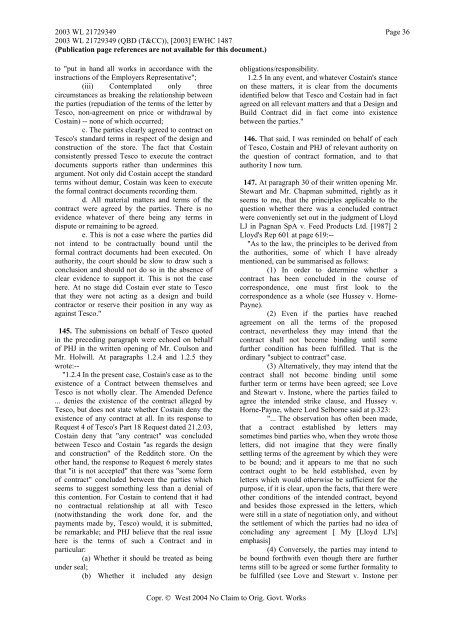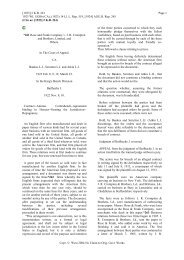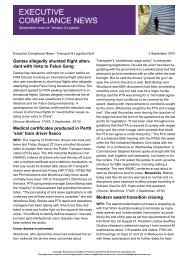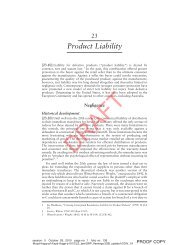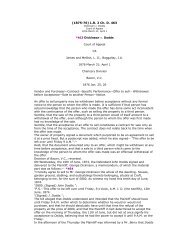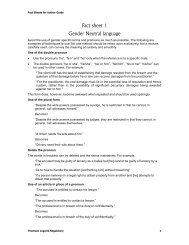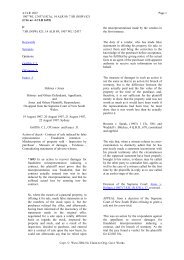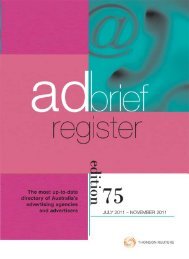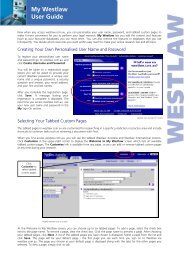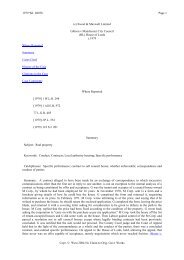Tesco v Constain - Thomson Reuters
Tesco v Constain - Thomson Reuters
Tesco v Constain - Thomson Reuters
Create successful ePaper yourself
Turn your PDF publications into a flip-book with our unique Google optimized e-Paper software.
2003 WL 21729349 Page 362003 WL 21729349 (QBD (T&CC)), [2003] EWHC 1487(Publication page references are not available for this document.)to "put in hand all works in accordance with theinstructions of the Employers Representative";(iii) Contemplated only threecircumstances as breaking the relationship betweenthe parties (repudiation of the terms of the letter by<strong>Tesco</strong>, non-agreement on price or withdrawal byCostain) -- none of which occurred;c. The parties clearly agreed to contract on<strong>Tesco</strong>'s standard terms in respect of the design andconstruction of the store. The fact that Costainconsistently pressed <strong>Tesco</strong> to execute the contractdocuments supports rather than undermines thisargument. Not only did Costain accept the standardterms without demur, Costain was keen to executethe formal contract documents recording them.d. All material matters and terms of thecontract were agreed by the parties. There is noevidence whatever of there being any terms indispute or remaining to be agreed.e. This is not a case where the parties didnot intend to be contractually bound until theformal contract documents had been executed. Onauthority, the court should be slow to draw such aconclusion and should not do so in the absence ofclear evidence to support it. This is not the casehere. At no stage did Costain ever state to <strong>Tesco</strong>that they were not acting as a design and buildcontractor or reserve their position in any way asagainst <strong>Tesco</strong>."145. The submissions on behalf of <strong>Tesco</strong> quotedin the preceding paragraph were echoed on behalfof PHJ in the written opening of Mr. Coulson andMr. Holwill. At paragraphs 1.2.4 and 1.2.5 theywrote:--"1.2.4 In the present case, Costain's case as to theexistence of a Contract between themselves and<strong>Tesco</strong> is not wholly clear. The Amended Defence... denies the existence of the contract alleged by<strong>Tesco</strong>, but does not state whether Costain deny theexistence of any contract at all. In its response toRequest 4 of <strong>Tesco</strong>'s Part 18 Request dated 21.2.03,Costain deny that "any contract" was concludedbetween <strong>Tesco</strong> and Costain "as regards the designand construction" of the Redditch store. On theother hand, the response to Request 6 merely statesthat "it is not accepted" that there was "some formof contract" concluded between the parties whichseems to suggest something less than a denial ofthis contention. For Costain to contend that it hadno contractual relationship at all with <strong>Tesco</strong>(notwithstanding the work done for, and thepayments made by, <strong>Tesco</strong>) would, it is submitted,be remarkable; and PHJ believe that the real issuehere is the terms of such a Contract and inparticular:(a) Whether it should be treated as beingunder seal;(b) Whether it included any designobligations/responsibility.1.2.5 In any event, and whatever Costain's stanceon these matters, it is clear from the documentsidentified below that <strong>Tesco</strong> and Costain had in factagreed on all relevant matters and that a Design andBuild Contract did in fact come into existencebetween the parties."146. That said, I was reminded on behalf of eachof <strong>Tesco</strong>, Costain and PHJ of relevant authority onthe question of contract formation, and to thatauthority I now turn.147. At paragraph 30 of their written opening Mr.Stewart and Mr. Chapman submitted, rightly as itseems to me, that the principles applicable to thequestion whether there was a concluded contractwere conveniently set out in the judgment of LloydLJ in Pagnan SpA v. Feed Products Ltd. [1987] 2Lloyd's Rep 601 at page 619:--"As to the law, the principles to be derived fromthe authorities, some of which I have alreadymentioned, can be summarised as follows:(1) In order to determine whether acontract has been concluded in the course ofcorrespondence, one must first look to thecorrespondence as a whole (see Hussey v. Horne-Payne).(2) Even if the parties have reachedagreement on all the terms of the proposedcontract, nevertheless they may intend that thecontract shall not become binding until somefurther condition has been fulfilled. That is theordinary "subject to contract" case.(3) Alternatively, they may intend that thecontract shall not become binding until somefurther term or terms have been agreed; see Loveand Stewart v. Instone, where the parties failed toagree the intended strike clause, and Hussey v.Horne-Payne, where Lord Selborne said at p.323:"... The observation has often been made,that a contract established by letters maysometimes bind parties who, when they wrote thoseletters, did not imagine that they were finallysettling terms of the agreement by which they wereto be bound; and it appears to me that no suchcontract ought to be held established, even byletters which would otherwise be sufficient for thepurpose, if it is clear, upon the facts, that there wereother conditions of the intended contract, beyondand besides those expressed in the letters, whichwere still in a state of negotiation only, and withoutthe settlement of which the parties had no idea ofconcluding any agreement [ My [Lloyd LJ's]emphasis](4) Conversely, the parties may intend tobe bound forthwith even though there are furtherterms still to be agreed or some further formality tobe fulfilled (see Love and Stewart v. Instone perCopr. © West 2004 No Claim to Orig. Govt. Works


